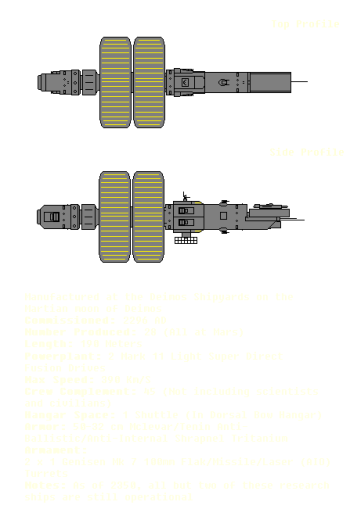
Gabatrix.net





© CMed (TheUniverseofCMed) 2021
Database and Lore

The Einstein Class Research Vessel
“We might not have the exploration battleships of the past, but we still have our research and exploration ships. It isn’t bad to be on one,” UHN serviceman stationed onboard the UHN Hawking. The first-ever purpose-built exploration vessel for the UHN, the Einstein class, was intended to allow humanity to explore the stars while leaving the battleships to defend home bases. They were simple yet effective in accomplishing their missions. Many star systems would be charted and mapped out in due thanks to the crews that operated these ships. Design The initial design of the Einstein class was to replace the former Ares class Battleships in the role of exploration. They would also be designed to be more advanced than the typical uncrewed probes used by the human race. True that much of the exploration was done by machines. Others knew that a living human touch was needed. Interests always persisted in wanting to investigate the unknown and evaluating what was out there. The Einstein was widely popular right from the start. The concept was to introduce a ship that could effectively take the role that former civilian ships had to perform. Scientists widely criticized the original transports that were being pressed into positions that they wouldn’t be good at. Other issues even arose that the cost of retrofitting transports to explore cost more money in the long run. The UHN and UWA had put their resources together. It was called upon to have fifteen of the Einsteins built. These ships were way more robust than the civilian ships. They even had AIO turrets installed so that they could provide basic protection. A forward-mounted shuttle bay and two centripetal rings provided an enormous amount of space and luxury for civilian families to operate onboard. Much of the interior could be easily adjusted to house supplies or other types of equipment for long voyages. Its deep scanning sensor equipment was better than any other form of surveillance or exploratory probes in existence. It could also hold a series of scanning probes in its large forward mounted bay, while housing a single shuttle. While it was technically a UHN ship, civilian contractors and scientists would operate alongside service individuals. The vessel could utilize basic solar sails or other equipment to help wait for rescue in emergency scenarios. All of the Einstein classes are named after famous individuals of Earth’s past. These people are responsible for encouraging generations of individuals to pioneer for the stars and beyond. History It is no surprise that the Einsteins had a good record. While they were never designed to go into a battle, many complemented what the ship was intended. The UHN also felt more inclined to retire the older battleships to replace them with more modern and combat-effective warships. With good steady maintenance, the research vessels could last for fifty years, ten years longer than their original expiration dates. The ships, crews, and scientists would spend years exploring the outer fringes of UWA space, cataloging over 100 light- years of various solar systems that lay beyond Sol and Mars. In fact, the Einstein class had become so popular that the civilian corporations and other research groups raised money to have new ships built. The UWA would further donate the funds to assist these groups in having their own research vessels. UHN service members complimented that the Einsteins were cozy to be onboard. There was so much space inside that most crew members actually had their own rooms without having to share them with another. Family members of the servicemen could even freely operate and share rooms. A few times, the Einsteins had been nicknamed the “Family SUV” for married couples. For some members in the UHN, the research vessels were the hopes and dreams of leaving and traversing the outside fringes of colonial space. For the civilian sector, they not only provided worthwhile jobs but allowed people to see things that they had never seen before. Ultimately, by the time it reached the 2340s, the legacy of the Einstein class was wearing out. Old parts used to take care of them were running out, and the UHN already had the newer Kepler class Research Vessel. By the time it reached 2349, only two of the original Einstein classes were still operational. The Tyson and Michio Kaku were both stationed to investigate and study the moons of the Sol system while conducting various other experiments. *Spoilers if you haven't read past Gabatrix: Minerva arc* It would be an Einstein class Research Vessel that would house one of the first experiments into a super-advanced AI. Initially banned, the UHN Tyson, named after Neil DeGrasse Tyson, would usher in the controversial development of Minerva. Created by Doctor Ericsson, he would safely ensure that Minera was kept in a remote area of space and away from most prying eyes. The Tyson at the time was a suitable location due to the fact that it was part of a long-term assignment to study the moons of the outer planets of Sol. The UHN command felt inclined to keep the ships “close” to their bases if a catastrophic breakdown were to ever occur. The Tyson and Michio Kaku were slated to be eventually retired in a few more years, although their condition was still relatively good. Ultimately, when humanity found out about Minerva, they wanted to terminate her and her future offspring. Using the Tyson as a leaping platform, the AI construct would completely overpower the computer networks of Mars. An agreement was struck to spare her and her future newborn. However, it would be the threat of the Itreans that drove the vessels back to Titan. Housed in the icy methane depths, the ships are expected to remain there until the scene is considered to be safe again. Once the threat of the alien race dies down, will the vessels be reactivated to continue their assignments.














